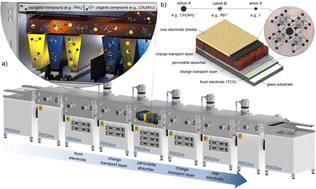Energy Environ. Sci., 2024, 17,1645-1663
DOI: 10.1039/D3EE03273F, Perspective
DOI: 10.1039/D3EE03273F, Perspective
 Open Access
Open Access This article is licensed under a Creative Commons Attribution 3.0 Unported Licence.
This article is licensed under a Creative Commons Attribution 3.0 Unported Licence.Tobias Abzieher, David T. Moore, Marcel Roß, Steve Albrecht, Jared Silvia, Hairen Tan, Quentin Jeangros, Christophe Ballif, Maximilian T. Hoerantner, Beom-Soo Kim, Henk J. Bolink, Paul Pistor, Jan Christoph Goldschmidt, Yu-Hsien Chiang, Samuel D. Stranks, Juliane Borchert, Michael D. McGehee, Monica Morales-Masis, Jay B. Patel, Annalisa Bruno, Ulrich W. Paetzold
While perovskite-based photovoltaics is progressing toward commercialization, it remains an open question which fabrication technology – solution-based, vapor-based, or combinations – will pave the way to faster economic breakthrough.
The content of this RSS Feed (c) The Royal Society of Chemistry
While perovskite-based photovoltaics is progressing toward commercialization, it remains an open question which fabrication technology – solution-based, vapor-based, or combinations – will pave the way to faster economic breakthrough.
The content of this RSS Feed (c) The Royal Society of Chemistry

